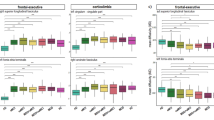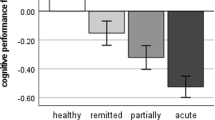Abstract
Objective
Lower white matter integrity of frontal-subcortical circuitry has been associated with late-life depression in normally aging older adults and with the presence of multiple sclerosis (MS). Frontal-striatal white matter tracts involved in executive, cognitive, emotion, and motor function may underlie depression in older adults with MS. The present study examined the association between depression score and frontal-striatal white matter integrity in older adults with MS and controls.
Methods
Older adults with MS (OAMS) (n = 67, mean age = 64.55 ± 3.89) and controls (n = 74, mean age = 69.04 ± 6.32) underwent brain MRI, cognitive assessment, psychological, and motoric testing. Depression was assessed through the 30-item Geriatric Depression Scale. Fractional anisotropy (FA) was extracted from two bilateral tracts: dorsolateral prefrontal cortex to putamen nucleus (DLPFC-pn) and dorsolateral prefrontal cortex to caudate nucleus (DLPFC-cn).
Results
OAMS reported significantly worse (i.e., higher) depression symptoms (β = .357, p < .001) compared to healthy controls. Adjusted moderation analyses revealed, via group by FA interactions, significantly stronger associations between FA of the left DLPFC-pn tract and total depression (B = − 61.70, p = .011) among OAMS compared to controls. Conditional effects revealed that lower FA of the left DLPFC-pn was significantly associated with worse (i.e., higher) depression symptoms (b = − 38.0, p = .028) only among OAMS. The other three tracts were not significant in moderation models.
Conclusions
We provided first evidence that lower white matter integrity of the left DLPFC-pn tract was related to worse depression in older adults with MS.

Similar content being viewed by others
Data Availability
Data will be provided to qualified investigators upon written request to the corresponding author.
References
Wootla B, Eriguchi M, Rodriguez M (2012) Is multiple sclerosis an autoimmune disease? Autoimmune Dis 2012:1–12
Vaughn CB et al (2019) Epidemiology and treatment of multiple sclerosis in elderly populations. Nat Rev Neurol 15(6):329–342
Patten SB, Beck CA, Williams JV, Barbui C, Metz L (2003) Major depression in multiple sclerosis: a population-based perspective. Neurology 61(11):1524–1527
Patten SB, Marrie RA, Carta MG (2017) Depression in multiple sclerosis. Int Rev Psychiatry 29(5):463–472
Salehpoor G, Rezaei S, Hosseininezhad M (2014) Quality of life in multiple sclerosis (MS) and role of fatigue, depression, anxiety, and stress: a bicenter study from north of Iran. Iran J Nurs Midwifery Res 19(6):593
Mohr DC, Goodkin DE, Likosky W, Gatto N, Baumann KA, Rudick RA (1997) Treatment of depression improves adherence to interferon beta-1b therapy for multiple sclerosis. Arch Neurol 54(5):531–533
Bonelli RM, Cummings JL (2007) Frontal-subcortical circuitry and behavior. Dialogues in Clin Neurosci 9(2):141–151
Kim Y-K, Han K-M (2021) Neural substrates for late-life depression: a selective review of structural neuroimaging studies. Prog Neuropsychopharmacol Biol Psychiatry 104:110010
Alexopoulos GS, Hoptman MJ, Kanellopoulos D, Murphy CF, Lim KO, Gunning FM (2012) Functional connectivity in the cognitive control network and the default mode network in late-life depression. J Affect Disord 139(1):56–65
Alexopoulos GS (2019) Mechanisms and treatment of late-life depression. Transl Psychiatry 9(1):188
Cummings JL (1995) Anatomic and behavioral aspects of frontal-subcortical circuits. Ann N Y Acad Sci 769:1–13
Koenigs M, Grafman J (2009) The functional neuroanatomy of depression: distinct roles for ventromedial and dorsolateral prefrontal cortex. Behav Brain Res 201(2):239–243
Monchi O, Petrides M, Strafella AP, Worsley KJ, Doyon J (2006) Functional role of the basal ganglia in the planning and execution of actions. Annal Neurol 59(2):257–264
Adams KB, Matto HC, Sanders S (2004) Confirmatory factor analysis of the geriatric depression scale. Gerontologist 44(6):818–826
Thompson AJ et al (2018) Diagnosis of multiple sclerosis: 2017 revisions of the McDonald criteria. Lancet Neurol 17(2):162–173
Learmonth YC, Motl RW, Sandroff BM, Pula JH, Cadavid D (2013) Validation of patient determined disease steps (PDDS) scale scores in persons with multiple sclerosis. BMC Neurol 13(1):1–8
Koch MW, Mostert JP, Wolinsky JS, Lublin FD, Uitdehaag B, Cutter GR (2021) Comparison of the EDSS, timed 25-foot walk, and the 9-hole peg test as clinical trial outcomes in relapsing-remitting multiple sclerosis. Neurology 97(16):e1560–e1570
Yesavage JA et al (1982) Development and validation of a geriatric depression screening scale: a preliminary report. J Psychiatr Res 17(1):37–49
Wancata J, Alexandrowicz R, Marquart B, Weiss M, Friedrich F (2006) The criterion validity of the Geriatric Depression Scale: a systematic review. Acta Psychiatr Scand 114(6):398–410
Tournier JD et al (2022) MRtrix3: A fast, flexible and open software framework for medical image processing and visualisation. Neuroimage 2022:116137. https://doi.org/10.1016/j.neuroimage.2019.116137
Evans AC, Janke AL, Collins DL, Baillet S (2012) Brain templates and atlases. Neuroimage 62(2):911–922. https://doi.org/10.1016/j.neuroimage.2012.01.024
Sallet J et al (2013) The organization of dorsal frontal cortex in humans and macaques. J Neurosci 33(30):12255–12274. https://doi.org/10.1523/JNEUROSCI.5108-12.2013
Desikan RS et al (2006) “An automated labeling system for subdividing the human cerebral cortex on MRI scans into gyral based regions of interest,” (in eng). Neuroimage 31(3):968–980. https://doi.org/10.1016/j.neuroimage.2006.01.021
Avants BB, Tustison NJ, Song G, Cook PA, Klein A, Gee JC (2011) A reproducible evaluation of ANTs similarity metric performance in brain image registration. Neuroimage 54(3):2033–2044. https://doi.org/10.1016/j.neuroimage.2010.09.025
Tournier JD, Calamante F, Gadian DG, Connelly A (2004) Direct estimation of the fiber orientation density function from diffusion-weighted MRI data using spherical deconvolution. Neuroimage 23(3):1176–1185. https://doi.org/10.1016/j.neuroimage.2004.07.037
Calamante F, Tournier JD, Jackson GD, Connelly A (2010) Track-density imaging (TDI): super-resolution white matter imaging using whole-brain track-density mapping. Neuroimage 53(4):1233–1243. https://doi.org/10.1016/j.neuroimage.2010.07.024
Zhang Y, Brady M, Smith S (2001) “Segmentation of brain MR images through a hidden Markov random field model and the expectation-maximization algorithm,” (in eng). IEEE Trans Med Imaging 20(1):45–57. https://doi.org/10.1109/42.906424
Duff K et al (2005) Test-retest stability and practice effects of the RBANS in a community dwelling elderly sample. J Clin Exp Neuropsychol 27(5):565–575
Holtzer R, Verghese J, Wang C, Hall CB, Lipton RB (2008) Within-person across-neuropsychological test variability and incident dementia. JAMA 300(7):823–830
Wang S, Blazer DG (2015) Depression and cognition in the elderly. Annu Rev Clin Psychol 11:331–360
Branco M et al (2019) Aging with multiple sclerosis: prevalence and profile of cognitive impairment. Neurol Sci 40:1651–1657
Hayes AF (2017) Introduction to mediation, moderation, and conditional process analysis: A regression-based approach. Guilford publications, New York. https://doi.org/10.1111/jedm.12050
Feinstein A, Magalhaes S, Richard J-F, Audet B, Moore C (2014) The link between multiple sclerosis and depression. Nat Rev Neurol 10(9):507–517
Krawczyk DC (2002) Contributions of the prefrontal cortex to the neural basis of human decision making. Neurosci Biobehav Rev 26(6):631–664
Starkstein SE, Robinson RG, Honig MA, Parikh RM, Joselyn J, Price TR (1989) Mood changes after right-hemisphere lesions. Br J Psychiatry 155(1):79–85
McIntosh AR (1999) Mapping cognition to the brain through neural interactions. Memory 7(5–6):523–548
Kroencke DC, Lynch SG, Denney DR (2000) Fatigue in multiple sclerosis: relationship to depression, disability, and disease pattern. Mult Scler J 6(2):131–136
Pardini M, Bonzano L, Mancardi GL, Roccatagliata L (2010) Frontal networks play a role in fatigue perception in multiple sclerosis. Behav Neurosci 124(3):329
Herbert E et al (2018) Fractional anisotropy of white matter, disability and blood iron parameters in multiple sclerosis. Metab Brain Dis 33(2):545–557
Zhuo Z et al (2021) Subtyping relapsing–remitting multiple sclerosis using structural MRI. J Neurol 268(5):1808–1817
Funding
This research was supported by the National Institute of Neurological Disorders and Stroke (NINDS) [R01NS109023].
Author information
Authors and Affiliations
Corresponding authors
Ethics declarations
Ethical approval
The work described in this manuscript has been executed in adherence with The Code of Ethics of the World Medical Association (Declaration of Helsinki). The Institutional Review Board of Albert Einstein College of Medicine approved this study. Written informed consent was obtained on the first in-person study visit.
Conflict of interest
The authors declare no competing interests.
Additional information
Publisher's Note
Springer Nature remains neutral with regard to jurisdictional claims in published maps and institutional affiliations.
Supplementary Information
Below is the link to the electronic supplementary material.
Rights and permissions
Springer Nature or its licensor (e.g. a society or other partner) holds exclusive rights to this article under a publishing agreement with the author(s) or other rightsholder(s); author self-archiving of the accepted manuscript version of this article is solely governed by the terms of such publishing agreement and applicable law.
About this article
Cite this article
Cote, S.E., Wagshul, M., Foley, F.W. et al. Frontal-striatal tract integrity and depression in older adults with and without multiple sclerosis. Neurol Sci (2024). https://doi.org/10.1007/s10072-024-07316-y
Received:
Accepted:
Published:
DOI: https://doi.org/10.1007/s10072-024-07316-y




